Reinventing yourself can be the just the thing you need to get you to your goals sooner. Think of it as your personal Hyperloop to success.
 Often times, you are limited by other people’s perception of you in an outside of work. “He’s not technical enough for this project” or “She’s too emotional under pressure”. And even worse, we limit ourselves by our self-perception “I’m not able to handle this situation”.
Often times, you are limited by other people’s perception of you in an outside of work. “He’s not technical enough for this project” or “She’s too emotional under pressure”. And even worse, we limit ourselves by our self-perception “I’m not able to handle this situation”.
Anyway you look at it, this is a major obstacle in the path of your potential. The remedy? Reinvent yourself and clear those obstacles in your path to bigger and better.
1) Form new and empowering mental models. Mental models are the calculated ways in which you think, react and recover from a situation. It’s built on past experiences that were both in and out of your control, good and bad. It’s the self-authored “User’s Guide to You”.
To reinvent yourself for the good, try outlining a new mental model to replace an existing self-destructive mental model. For example, If your existing mental model regarding mistakes is: I made a mistake at work, the last time I made a mistake at work I was called incompetent, therefore, I am incompetent.
Try Replacing it with a new mental model like; I made a mistake at work, I understand and respect the process of learning and the learning curve or It impossible to avoid mistakes completely in the workplace and therefore, I am human.
2) Act “as if”. Your newly constructed mental model must be planted deep in your psyche in order to take root. During this transitionary phase, you act “as if”.
Think of yourself as an actor/actress during a dress rehearsal. You wear your new mental model and you act as if you would if this were your mental model from birth. You make a mistake at work, you respond not react and you do what needs to be done in order to resolve the mistake. You keep cool knowing that mistakes happen and you don’t beat yourself up incessantly or take it as an indictment on you or what it “must” mean about or your ability to do high-quality work.
This can sometimes be the most challenging step because it requires intense mindful and conscious effort, but it is also the most transformative step. (this is where the magic happens!)
3) Practice. In order to cut the transition time down, you must practice implementing this and other newly formed mental models as much as possible. Take any and every opportunity to study your current mental model and determine whether or not it has been serving you well.
Like any activity, the more you practice it the better you will become at it. Challenge yourself to strengthen newly-formed models and create new models regularly.

